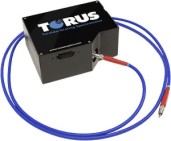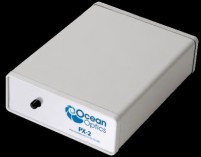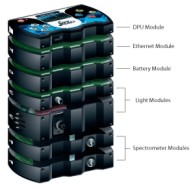 |
Torus Miniature Fiber Optic Spectrometer (detector)
The Torus Miniature Spectrometer from Ocean Optics is a Visible range (360-825 nm) unit that delivers low stray light (0.015% at 400 nm) and high throughput.
Torus delivers scientific-grade performance with outstanding thermal stability, making it a brilliant choice for color measurement of LEDs and absorbance measurements up to 3.0 OD.
3 versions
TORUS-25
- Concave Grating Spectrometer
- Pre-configured with 25 µm Slit
TORUS-25-OSF
- Concave Grating Spectrometer
- Pre-configured with 25 µm Slit and Order-Sorting Filter
TORUS-50
- Concave Grating Spectrometer
- Pre-configured with 50 µm Slit
Spécifications
- Dimensions: 149.9 mm x 119.4 mm x 63.5 mm
- Weight: 954 g
Detector
- Type: Sony ILX511B
- Range: 200-1100 nm
- Pixels/size: 2048
Spectroscopic
- Wavelength range: 360-825 nm
- Optical resolution: <1.6 nm FWHM over the spectral range
- Signal-to-Noise ratio: 250:1 at full signal
- A/D resolution: 16 bits
- Dark noise: 50 RMS counts; 300 counts peak to peak
- Dynamic range: 8.5x107 (system); 1300:1 (single acquisition)
- Integration time: 1 ms - 65 s
- Stray light: 0.015% SRPR @ 400 nm
- Wavelength thermal stability: 0.0056 nm/ ºC
- Corrected linearity: >99%
- Certification: CE Mark, RoHS
|

Application exemple: FIA

|
USB4000 Miniature Fiber Optic Spectrometer (detector)
- The USB4000 is the last-generation flagship spectrometer, with a 3648-element Toshiba linear CCD array for increased signal-to-noise and enhanced electronics for controlling the spectrometer and accessories.
- The Integration Time setting in our software is specified by the user. It's analogous to the shutter speed of a camera: the value specified for the integration time is the amount of time the detector "looks" at the incoming photons. Because the Toshiba detector has an electronic shutter, using software you can specify minimum integration times as short as 10 µs, allowing you to measure transient events like laser pulses. The ability to integrate the spectrometer for brief durations eliminates saturation problems that can occur in high light-level applications such as laser analysis.
- The USB4000's onboard programmable microcontroller provides you with considerable flexibility in controlling the spectrometer and accessories. Through a 22-pin connector, you can implement all operating parameters in the software: control light sources, create processes, and retrieve information on external objects. You have access to 8 user-programmable digital Inputs/Outputs for interfacing to other equipment.
- The USB4000 provides you with an affordable, high-performance 3648-element linear CCD-array detector with an optical bench that's small enough to fit into the palm of your hand. The USB4000 works the same way as other Ocean Optics spectrometers; it accepts light energy transmitted through single-strand optical fiber and disperses it via a fixed grating across the linear CCD array detector, which is responsive from 200-1100 nm.
- At Ocean Optics, we understand that your work is unique and that you want a spectrometer to fit your specific needs. Working with one of our application scientists, we help you determine which configuration will best work for you. When selecting the USB4000 -- you can choose from 14 gratings, 6 slits and hundreds of fiber optic accessories such as light sources, probes and optical fibers to create the optimal system for your application.
- When you purchase a USB4000, you can also choose from Ocean Optics' complete line of spectroscopic accessories. Most accessories have SMA 905 connectors for application flexibility. Changing the sampling system is as easy as unscrewing a connector and adding new components or accessories, such as light sources, sampling holders, filter holders, flow cells, fiber optic probes and sensors, collimating lenses, attenuators, diffuse reflectance standards, integrating spheres and our extensive line of optical fibers.
- To properly configure a USB4000 Spectrometer for your application, you'll need to specify one of the detector options listed in the table below.
| DET4-200-850 |
sorting filter 200-850 nm |
| DET4-350-1000 |
sorting filter 300-1000 nm |
| DET4-UV |
UV upgrade |
| DET4-VIS |
VIS |
- The USB4000 interfaces to a PC, PLC or other embedded controllers via USB 2.0 or RS-232 serial port. Data unique to each spectrometer is programmed into a memory chip on the USB4000; our spectrometer operating software reads these values for easy setup and hot swapping among PCs.
- Serial port operation tips: When using the serial port, the USB4000 requires a single 5-volt power supply (not included). Also, SpectraSuite Spectroscopy Software does not support spectrometer operation via the serial port. However, using the included Serial Port Command Set, you can write your own software that makes serial port operation possible.
- For on line mesaurement
Spécifications
- Dimensions: 89.1 mm x 63.3 mm x 34.4 mm
- Weight: 190 grams
- Toshiba TCD1304AP Linear CCD array
- Detector range: 200-1100 nm
- Pixels: 3648 pixels
- Pixel size: 8 um x 200 um
- Pixel well depth: 100,000 electrons
- Signal-to-noise ratio: 300:1 (at full signal)
- A/D resolution: 16 bit
- Dark noise: 12 RMS counts
- Corrected linearity: >99.8%
- Sensitivity: 130 photons/count at 400 nm; 60 photons/count at 600 nm
- Optical Bench Design: f/4, Asymmetrical crossed Czerny-Turner
- Focal length: 42 mm input; 68 mm output
- Entrance aperture: 5, 10, 25, 50, 100 or 200 µm wide slits or fiber (no slit)
- Grating options: 14 different grating options, UV through Shortwave NIR
- HC-1 grating option: No
- Detector collection lens option: Yes, L4
- OFLV filter options: OFLV-200-850; OFLV-350-1000
- Other bench filter options: Longpass OF-1 filters
- Collimating and focusing mirrors: Standard or SAG+UPG
- UV enhanced window: Yes, UV4
- Fiber optic connector: SMA 905 to 0.22 numerical aperture single-strand optical fiber
- Wavelength range: Grating dependent
- Optical resolution: ~0.3-10.0 nm FWHM
- Signal-to-noise ratio: 300:1 (at full signal)
- A/D resolution; 16 bit
- Dark noise: 24 RMS counts
- Integration time: 10 µs to 65 seconds
- Dynamic range: 2 x 108 (system), 1300:1 for a single acquisition
- Stray light: <0.05% at 600 nm; 0.10% at 435 nm
- Power consumption: 250 mA @ 5 VDC
- Data transfer speed: Full spectrum to memory every 4 ms with USB 2.0 port, 18 ms with USB 1.1 port
- Inputs/Outputs: Yes, 8 onboard digital user-programmable GPIOs
- Analog channels: No
- Auto nulling: Yes
- Breakout box compatible: Yes, USB4-BREAKOUT
- Trigger modes: 5 modes
- Strobe functions: Yes
- Connector: 22-pin connector
- Operating systems: Windows 98/Me/2000/XP, Mac OS X and Linux with USB port; Any 32-bit Windows OS with serial port
- Computer interfaces: USB 2.0 @ 480 Mbps (USB1.1 compatible); RS-232 (2-wire) @ 115.2 K baud
- Peripheral interfaces: SPI (3-wire); I2C inter-integrated circuit
|
 |
General Purpose Transmission Dip Probes T300-RT and T200-RT
These probes are especially useful for embedding into process streams for in situ, real-time sample monitoring.
The are more suitable for liquid solutions.
The probe has two fibers projecting light through a shared lens. Light from the source is focused by the lens onto a mirror across the sample gap. The light is reflected back through the lens to the read fiber, which brings the light to the spectrometer. The lenses are focused for use in water, and if used in air, will be severely out of focus and inefficient.
Specifications
- Fiber type T300: 300 um solarization-resistant UV-VIS or VIS-NIR optical
- Fiber type T200: 200 um VIS-NIR optical fiber
- Outer diameter: 6.35 mm
- Probe length: 127 mm
- Fiber length: 2 meters
- Breakout: 1.0 meters from the end of the probe
- Optics: Fused silica
- Probe wetted materials: Stainless steel, fused silica, Epotek 353ND
- Pathlength: 2, 5 or 10 mm
- Internal materials: Second surface aluminum mirror
- Pressure: 100 psi
- Fiber jacketing: PVC Monocoil - PVDF zip tube
- Probe sleeve: Stainless steel (300 series)
- Connector: SMA 905
- Operating temperature: Up to 100 ºC without sleeve
|
 |
Pulsed Xenon Light Source PX2
high flash rate, short-arc xenon lamp for the UV (220-750 nm)
The PX-2 operates at speeds up to 220 Hz, offers excellent pulse-topulse stability and has two trigger modes for software control of the flash rate.
The flash rate is modified by changing the integration period. Because it produces a pulsed signal, the PX-2 is less likely to contribute to solarization in optical fiber assemblies, which can occur when fibers are illuminated with signal <300 nm.
Specifications
- Spectral range: 220-750 nm
- Approximate dimensions: 140 mm x 105 mm x 40 mm (LWH)
- Power input: 1.3 A at 11V and 220 Hz, 100 mA at 12V and 10Hz
- Trigger input: external TTL positive pulse via 15-pin connector
- Output: 45 microjoules per pulse maximum, 9.9 watts average power from bulb, 220 Hz pulse rate maximum
- Pulse duration: 5 microseconds (at 1/3 height of pulse)
- Lifetime: 230 days continuous operation at 50 Hz pulse rate
- Aperture: 3 mm
- Connector: SMA 905
- Timing signals available: Multiple mode: up to 220 Hz (varies with A/D samplingfrequency); Single mode: varies with scan rate
|
 |
bluLoop Multi-LED Light Source
bluLoop features four tunable LEDs that allow unparalleled balancing of spectral output. It delivers higher reliability of estimated color values, has low heat consumption and has a longer lifetime than typical halogen sources
- Dimensions (H x L x D): 62 x 60 x 150
- Weight (kg): 0.5
- Power consumption: up to 12 W
- Output to bulb: Blue lmax 500 mA
- Cyan lmax 700 mA
- White LED 65000 lmax 700 mA
- White LED 4500 lmax 700 mA
- Wavelength range: 395-750 nm
- Stability: 0.25%
- Drift: <0.3% per hour
- Time to stabilize: 15 minutes
- Bulb lifetime: >10,000 hours
- Temperature: 5-35 °C
- Humidity: 5-95% at 40 °C
|
 |
Jaz Modular Optical Sensing Suite
Jaz is a community of stackable, modular and autonomous components that combine to create a family of smart sensing instruments.
Rechargeable Lithium-Ion battery
Up to 8 spectrometer modules
Powerful microprocessor and onboard display eliminate the need for a PC
Stackable, autonomous instrument modules allow you to customize the system to your changing application needs.
Ethernet connectivity plus an SD card for data storage make remote operation a snap
|
 |
FLAME-BUNDLE-FL Spectrometer Application-Ready System for Fluorescence
This bundle contains everything you need for fluorescence measurements including the latest Flame spectrometer, OceanView software and sampling accessories. While a 365nm LLS LED excitation source is standard you can have a range of options from 240nm – 627nm.
What is included:
Spectrometer: FLAME-S-VIS-NIR-ES (350-1000 nm)
Interchangeable Slits: Kit of 5, 10, 25, 50, 100 and 200 um SMA connectors
Light Source: High-power 365 nm LED (other wavelengths available)
Sampling Accessories: CUV-ALL-UV cuvette holder, cuvette cover, 1 x quartz cuvette
Fibers and Probes: 600 um premium fiber, 25 cm long
Software: OceanView
|
|
|











